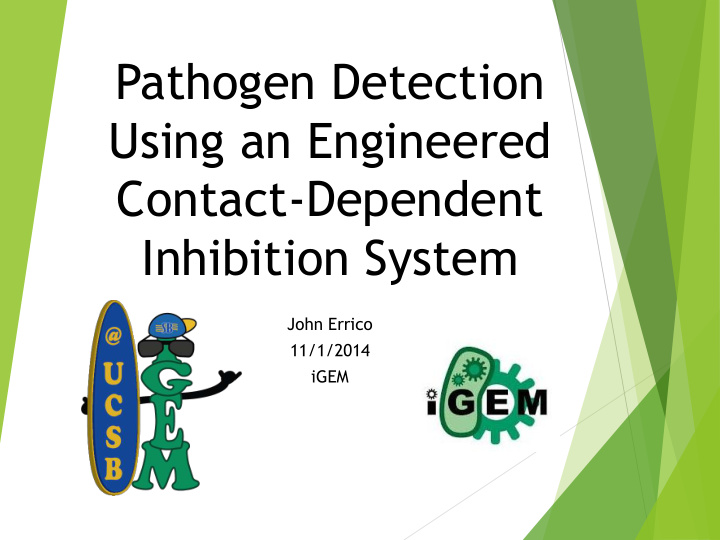



Pathogen Detection Using an Engineered Contact-Dependent Inhibition System John Errico 11/1/2014 iGEM
Human Practices “I Nano Days” SB County Science Fair
What is the Allosphere? Image from http://www.nsf.gov/discoveries/disc_images.jsp?cntn_id=121535&org=NSF For more information: http://www.allosphere.ucsb.edu/ A simulated 3D immersive environment at UCSB
CDI stands for contact-dependent inhibition • A bacterial defense and communication strategy • Injected toxins act as non-specific DNases, RNases, etc. Ruhe, Low, & Hayes. Trends in Microbiology (2013) • Mechanisms for self-strain protection against toxin (CdiI)
CDI is composed of 3 genes CT - Toxin Sequence Conserved VENN Sequence • CdiB is a membrane- ‘stick’ ‘base’ b ound ‘base’ for CdiA CdiI - Immunity Protein Ruhe, Low, & Hayes. Trends in Microbiology (2013) • CdiA is the ‘stick’ with toxin attached to end, cleaved @ conserved VENN sequence – binds BamA • CdiI is an immunity protein specific for upstream toxin that prevents self-killing
CT may need a permissive factor to become active When CT binds CysK (permissive factor), enzymatic activity is enabled Both CysK and Immunity can bind CT to form a ternary complex
Bacterial two-hybrid systems detect protein-protein interactions One half of Adenylate Cyclase (T25) fused to protein X, other half (T18) fused to Protein Y If Proteins X/Y interact, Adenylate Cyclase forms cAMP production identifies protein-protein interactions Adapted from Karimova G et al. PNAS 1998;95:5752-5756
cAMP production turns on gene synthesis Pap operon is a chromosomal promoter dependent on cAMP – only source of cAMP is from our system Gene of interest must be transduced using a bacteriophage
CysK-T25 was made using OE-PCR Overlapping Primers CysK forward primer w/ EcoRI site CysK (~800bp) T25 (~1000bp) T25 reverse primer w/ PstI site Linker = Gly-Thr-Gly-Ser PCR, longer extension period Fused CysK-T25 product Fused PCR product ligated into Tetracycline resistant backbone, transformed, checked with restriction analysis: 1.8Kbp = CysK-T25
I-T18 was extracted from pre-existing plasmid with PCR EcoRI 5’ 3’ T18 I U T25 PstI Standard PCR EcoRI PstI T18 5’ 3’ I Ligation into Ampicillin resistant backbone, transformation, check with restriction analysis: Faint 1Kbp = I-T18
Bacteriophage steal DNA randomly from a host Introduce GFP-grown phage to cell line, select for Kan R colonies
Bacteria did not glow upon contact – Why? Linker length may be not be long enough - Ternary vs. Binary Vs. Adapted from Karimova G et al. PNAS 1998;95:5752-5756 Endogenous CysK may be interfering – competitive antagonist Couldn’t control by transfecting commercial binary two - hybrid construct – Conflicting antibiotic resistances
The Future – a very customizable system -Contact-dependent bacterial strain – Can include as many immunities as necessary -Secondary messenger produced – cGMP? -Gene synthesized – multi-gene cascade systems? -Antibiotic production? – extremely specific killing Think T-cells
Gene Expression Pathogen Detection Using an Engineered Contact-Dependent Inhibition System John Errico 11/1/2014 iGEM
Acknowledgements Advisors: David Low, Omar Saleh Mentors: Christina Beck, Dan Nguyen Lab space: Chris Hayes The Team: Zachary Haynes, Travis Smith, Hiro Sparks, Katie Lee, Sarah Lensch, Andrew Ballin, Daniel Reinhart, Colton Bracken, & Tsuyoshi Kohlgruber And of course… iGEM!
Thank you! Questions?
Recommend
More recommend